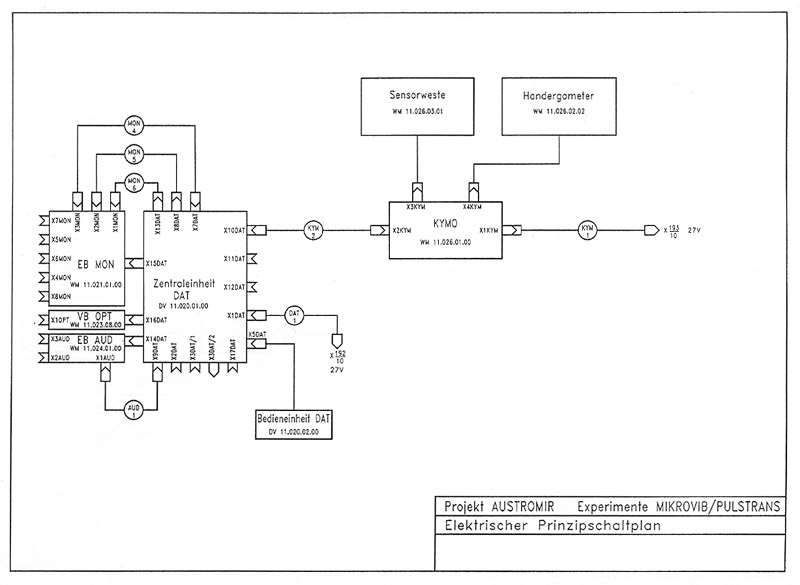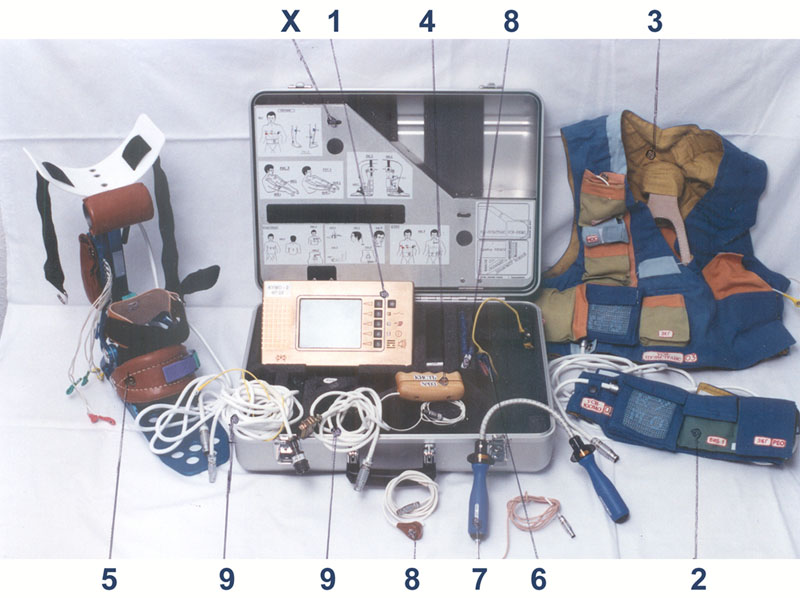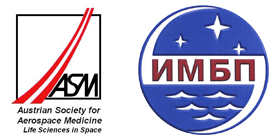With arbitrary muscular relaxation (lying, relaxed sitting), small vibrations on the muscle-skeletal system occur, with a typical frequency of 8 to 12 Hz. This so-called micro-vibration is provoked through the remaining autonomous muscular relaxation in the body as a result of gravity. In weightlessness, that is during total relaxation (cosmonaut in a free-floating state), this micro-vibration does not occur anymore. This could be first clearly shown within the framework of the AUSTROMIR mission. Incidentally, the micro-vibration was discovered by coincidence by the Austrian Hubert Rohracher in the forties of the last century. The clarification of the micro-vibration’s appearance mechanism was also the main goal of the AUSTROMIR project, hence the name “Experiment MIKROVIB”.
Further concrete evidence that micro-vibration is activated through the heartbeat was shown from the research results of AUSTROMIR. For this purpose, a mathematical model of the tense muscle, analogue to the tension of a string in a musical instrument, was developed. If the lightly tense muscle fibre is “stricken” through a heart impulse, resonance vibrations of 8 to 12 Hz can be observed as micro-vibration on the body surface. In weightlessness – that is by total missing muscle tension – no vibrations based on the model occur. The validation of this “heartbeat hypothesis” required additional examinations within the framework of the RLF Project.
During stationary tasks, further small tremor movements (force tremor, physiological tremor) occur at the extremities additional to micro-vibration. Examples are the trembling when holding a camera or whilst passing a thread through a needle eye, whereby intensification can result during stress situations. The origin of this trembling is by far more complex and rather interpreted on the level of the nervous and muscular system. The characteristic of this tremor movement (amplitude, frequency) depends furthermore on a number or exterior and interior factors. Exterior factors include the movement task type and the strain type, whereby even weightlessness plays its part. Interior factors include changes in the nervous and muscular system, whereby even stress and medicaments can have an influence.
Objectives
Two large batteries of questions arose for the program within the RLF project. Firstly, the AUSTROMIR results had to be assured. Besides, the Russian cosmonauts had to first repeat the experiments, whereby the experiment records were partially enhanced and refined. During AUSTROMIR, we had the task to examine the influence of autonomous muscle tension for various micro-movement phenomena (micro-vibration, stop-tremor). This was purely associated with the weightlessness effect and short-term effects. The RLF Project additionally took long-term effects into consideration, such as those that would be expected on a trip to Mars. As a result of the persistent omission of weightlessness, strong changes in the nervous and muscular system resulted. An expansion to the experiment methodology was required in order to record these changes, especially when examining tremor movements.
The first battery of questions concerned about whether the existence of micro-vibration actually depended on the muscle tension, as well as if it lies near to the above exemplary description. In order to validate this, micro-vibration in weightlessness was not only recorded during relaxation, but also during various tensions and body postures in a free-floating state. Pursuant to the model, micro-vibration must occur again in the tension phases as well in weightlessness. This examination required that a second cosmonaut operated the KYMO apparatus in order to record the corresponding measurement signals. With the help of a frequency analysis of the recorded signal, this question could then be answered.
The second battery of questions concerned about the long-term changes in the nervous and muscular system. A strong reduction and reorganization of the extensors occurs during long-term flights, especially in the legs. The reduction can be kept within limits through daily strength training, but because the training strain is not comparable with the natural gravity strain, the rate of non-exhaustible slow muscle fibres however decreases considerably. Therefore, an important research goal was to develop a simple non-invasive method that rates these changes. The method is based on the analysis of the automatic force vibrations occurring during a contraction, the so-called force tremor. For this purpose, a new foot-dynamometer was developed for the RLF project (see KYMO-2), that enables the simultaneous recording of electric signals in the muscle.
The changes in the nervous system especially pertain to the movement regulation. Due to missing body position signals from the equilibrium organ and changed signals of the body periphery, the nervous system must customize the movement coordination and the strength dose in the new “force environment”. This customization in weightlessness functions mostly automatically through so-called reflexes. The reflexes are also partially inoperable, approximately the reflexes for the compensation of gravity in the extensors. Therefore, changes in the reflex paths and their control centres occur with increasing sojourn duration, and these are particularly noticeable after re-entry. A possibility to evaluate these changes consists in the analysis of the occurrence of tremor movements like by stopping against gravity or by pulling an elastic string. A special expander was manufactured for the RLF project.
Functionality, Measuring principle
The securing of the results from AUSTROMIR and the further research of micro-vibration took place with the help of the KYMO apparatus already onboard. An enhanced apparatus, KYMO-2, was deployed for the formulation of the new research goals. Firstly, a software-upgrade was carried out on the existing apparatus (through the DATAMIR onboard computer). This was required in order to record the micro-vibration even during various tensions and body postures of the free-floating cosmonauts. The recordings were carried out once again on the right forearm with the help of two sensitive acceleration sensors on the elbow and arm joint. The ECG was again registered in order to study the influence of the activity of the heart. Even the other experiment parts from AUSTROMIR (hand-pressure measurement, precision of force amendment) were repeated in the RLF project. For the purpose of data storage, the measurement data registered were transferred to the DATAMIR onboard computer at the conclusion of every experiment cycle.
The foot-dynamometer from KYMO-2 was used for the examination of the changes in the muscular system. A particular force level can be adjusted through pressure on the foot pedal and in connection with the monitor display. Once again, static (foot pressure kept constant) and dynamic tests (force amendment with the help of a display marker) were carried out, similar in the past during hand strength. The maximal strength was also registered for the determination of the performance capability of the calf muscles. The registration of the contraction strength takes place through a measuring cell on the pedal. The strength oscillation can then be extracted from the strength signal with the help of an electronic filter. This strength oscillation is “highly amplified” and then registered with its own measuring channel. Additionally, the electric signals of the three most important calf muscles are registered. These signals can be used to evaluate muscle fatigue.
The examinations of the changes of stopping control with the help of tremor signals was carried out through raising the arms and pulling of the arm expander. The tremor whilst raising the arms was again recorded with the help of the acceleration sensors located on the arm joints. Drag was measured in the arm expander. Thereby, the contraction level could be monitored. The strength oscillation was extracted with the help of an electronic filter from the strength signal even here. Both signals were recorded additional to acceleration signals so that multiple signals were available for the evaluation of the tremor. The various mechanical signals that can be registered from the muscle-skeletal system were also referred to as “mechanomyogramm” (MMG).
Shared equipments of the Austrian payload
DATAMIR, KYMO, KYMO-2
Results
Many examinations were simulated for all experiment parts during and after the space-flight so that comparisons could be done. The signal quality was good to very good in most cases so that this analysis could be conducted and therewith significant results could be extracted. The micro-vibration results agree widely with the model expectations so that the “heartbeat hypothesis” could be confirmed as emergence cause. This shows that micro-vibration occurred again during the tensions in weightlessness in all cosmonauts examined. Without tension, the heartbeat was recognizable in the signal. It didn’t result in the typical oscillation patterns. The results from this experiment part can be used to evaluate muscle tension. Many persons suffer from increase muscle tension, causing pain or also provoking changes in the movement apparatus.
Many examinations were simulated for all experiment parts during and after the space-flight so that comparisons could be done. The signal quality was good to very good in most cases so that this analysis could be conducted and therewith significant results could be extracted. The micro-vibration results agree widely with the model expectations so that the “heartbeat hypothesis” could be confirmed as emergence cause. This shows that micro-vibration occurred again during the tensions in weightlessness in all cosmonauts examined. Without tension, the heartbeat was recognizable in the signal. It didn’t result in the typical oscillation patterns. The results from this experiment part can be used to evaluate muscle tension. Many persons suffer from increase muscle tension, causing pain or also provoking changes in the movement apparatus.
On the other hand, the results extracted from the stop tremor show a clear picture once more. Based on the reference measurements before the flight (standard values), one moves nearly “without shaking” in weightlessness (strong reduction of the tremor amplitude). The cause for this effect is to be found in the strength effort for stop movements. However, the expander tasks always resulted in the same strength level, barely showing this effect. But after the long-term flights, the “trembling” during both test tasks (raise arms, pull expander) were highly increased as compared to the standard values. The increased tremor amplitude reduces itself after two weeks back to the standard values. The cause for this post-flight effect can be found in the customization processes of the nervous system illustrated above (regulation of the “reflex cycles”). Such effects occur even on earth, for example even after long bed-ridden situations.
Technical characteristics
The equipment MIKROVIB consisted of the following units


Aluminium container with foam coating
- Equipment KYMO
- Cable KYM1 (power supply)
- Cable KYM2 (connection KYMO – DATAMIR)
- Sensor vest with
Vibrostimulator
Accelerometer (2 pieces)
Puls sensores (3 pieces)
ECG – cable
Pre-amplifier unit - Hand ergometer
- Accessory sets for the experiment MIKROVIB (2 pieces)
Adherance rings (3 pieces), Adherance discs (6 pieces)
Cleaning tissues (2 pieces), ECG – Electrodes (3 pieces) - Accessory sets for the experiment PULSTRANS (2 pieces)
Adherance rings (3 pieces), Adherance discs (6 pieces)
Cleaning tissues (2 pieces), ECG – Electrodes (3 pieces) - Accessory sets for the experiment SLEEP (2 pieces)
Adherance rings (3 pieces), Adherance discs (6 pieces)
Cleaning tissues (2 pieces), ECG – Electrodes (3 pieces) - Fixing devices for the puls sensors (3 pieces)
- Adhesive tapes to fix the vibrostimulator and
accelerometer on the skin of the subject - Jig for the standardised fixation of vibrostimulator and
accelerometer on the skin of the subject - Reserve assurance
| Mass: | max. 6.2 kg |
| Dimensions: | 350 mm x 350 mm x 140 mm |
| Power input: | max. 35 W |
- Equipment KYMO-2 (used in the Phase RLF-3)
- (1) Microprocessor unit (Experiment conduction, Data recording)
- (2) Measurement belt for bodysignals (Accelerometer, EKG, respiration)
- (3) Puls- and ballistocardiography-sensorvest
- (4) Force measurement: hand dynamometer
- (5) Force measurement: pedestal dynamometer with EMG-system
- (6) Cervical clip for the carotid puls sensor
- (7) Force measurement: expander
- (8) Sensor for the respiratory pressure with mouthpieces
- (9) Cable (Mains supply, board computer
- (X) Transport container


Experimenters
Univ.-Prof. Dr. Thomas Kenner (institute manager)
Dipl.-Ing. Dr. Eugen Gallasch (project manager)
Dipl.-Ing. Dr. Dietmar Rafolt
all: Physiological Institute of the University Graz
A. Konev
Prof. Dr. Inessa Benediktina Koslovskaja
A. Ivanov
all: IMBP (Institute for Biomedical Problems), Moscow
